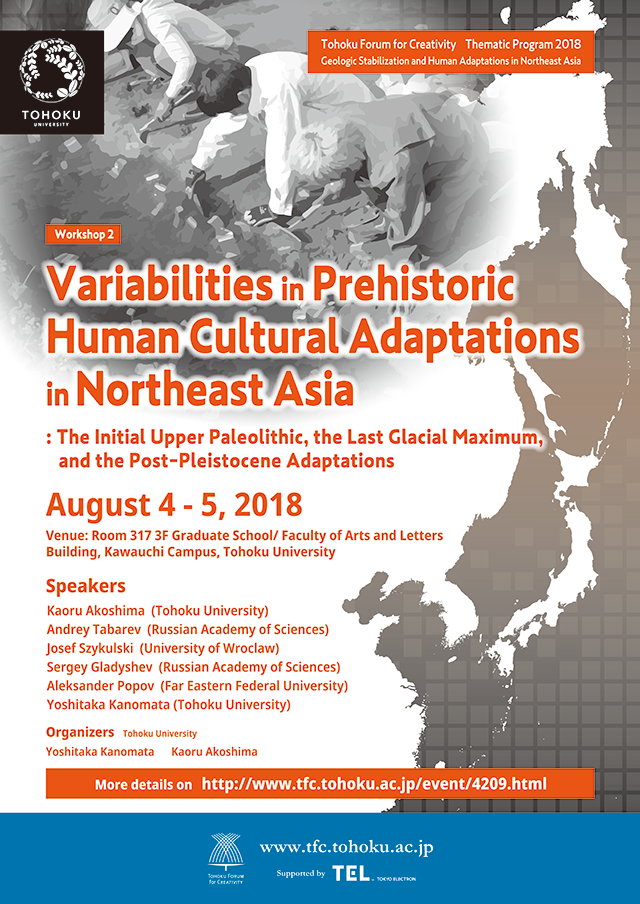Workshop 2: Variabilities in Prehistoric Human Cultural Adaptations in Northeast Asia: The Initial Upper Paleolithic, the Last Glacial Maximum, and the Post–Pleistocene Adaptations
Information
Expansion of modern humans into the arctic landscape during prehistoric times was
the complicated processes of interaction between fluctuating environments and diversity in cultural measures of adaptation.
The workshop aims to shed light on the territorial expansion of prehistoric populations throughout Northeast Asia,
their variabilities in subsistence and technology, and successes and failures in exploitations of natural resources
such as game animals, plant crops,
and specific geological rock types in the landscape as raw materials for tools in highly mobile settlement patterns.
The interdisciplinary program entails specialists in the Far Eastern Paleolithic archaeology, microscopic stone tool analysis,
geological landscape, and diachronic environmental reconstructions.
The focus of discussion centers on critical time periods when the strict environments of the arctic placed selection pressures
onto human populations with cultural means of adaptations.
The Initial Upper Paleolithic (ca.40,000 to 35,000 BP) was the period of transition from the discoidal core based industries
toward more efficient blade based industries.
Human group mobility increased and selection of certain high quality lithic raw materials,
with deepening planning depth of subsistence activities, and symbolic group identification.
The last Glacial maximum (LGM) was the period of the harshest cold times in some parts of Northeast Asia.
The ever refined systems of cultural adaptation led humans to enlarge their habitats to the arctic and then to the Beringia.
The most developed forms of stone tool making technology such as micro–blade production,
blade based projectile points with spear throwers,
with strict selection of lithic raw materials in the seasonal cycles of human migration,
with developed bone/antler tool technology, and artistic representation of figurines.
With the abrupt global warming during the terminal Pleistocene placed new selective pressure on human groups in the Northeast Asia.
Some populations invented ceramics, some groups intensified in aquatic resources to
form shell–middens, some combined hunting with cultivations.
The program thoroughly investigates these complex processes of cultural adaptations throughout Northeast Asian prehistory,
from eastern Siberia,
the Maritime region, the Japanese Archipelago, and the land bridge area of Beringia to Alaska.
The regional archaeological specialists from Russia, Poland and Japan with an interdisciplinary team
with geological landscape and environmental reconstruction will decipher the complex processes of human cultural adaptations
during the coldest periods in the Quaternary in the coldest region on the earth.
Date
August 4, 2018 – August 5, 2018
Venue
Room 317 3F Graduate School / Faculty of Arts and Letters Building, Kawauchi Campus, Tohoku University [Access]
Speakers
Kaoru Akoshima (Tohoku University)
Andrey Tabarev (Russian Academy of Sciences)
Josef Szykulski (University of Wroclaw)
Sergey Gladyshev (Russian Academy of Sciences)
Aleksander Popov (Far Eastern Federal University)
Yoshitaka Kanomata (Tohoku University)
Time Schedule
- Saturday, August 4, 2018
- 10:00 – 10:10
- Hiroki Takakura (Tohoku University)
- Opening address
- 10:10 – 11:00
- Kaoru Akoshima (Tohoku University)
- Toward the explanation of variabilities in prehistoric human cultural adaptations in Northeast Asia
- 11:00 – 12:00
- Andrey Tabarev (Russian Academy of Sciences)
- All inclusive (blades, microblades, bifaces): On the variability of the Late Paleolithic Tool–kit in the industries of Mongolia and Russian Far East
- 12:00 – 13:30
- Lunch break
- 13:30 – 14:30
- Josef Szykulski (University of Wroclaw)
- Late Pleistocene jasper cache from the Arts Bogdyn Nuruu massif in the Gobi Altai Mountains and the problem of its interpretation
- 14:30 – 15:30
- Sergey Gladyshev (Russian Academy of Sciences)
- Microcores and microblades as the marker of the Initial and Early Upper Paleolithic complexes manifestation, Mongolia
- Sunday, August 5, 2018
- 10:00 – 11:00
- Aleksander Popov (Far Eastern Federal University)
- Archaeological cultures and human adaptation during Post–Glacial era in the south of the Far East of Russia
- 11:00 – 12:00
- Yoshitaka Kanomata (Tohoku University)
- Cultural adaptations from the Last Glacial Maximum to the Post–Pleistocene in Japanese archipelago
- 12:00 – 13:30
- Lunch
- 13:30 – 14:30
- Discussion
Abstract [Apr. 9, 2019 Updated]
- Download [PDF]
Contributor
Andrey Tabarev (Russian Academy of Sciences)
Organizers
Yoshitaka Kanomata (Tohoku University)
Kaoru Akoshima (Tohoku University)
Contact
Juthatip Wiwattanapantuwong
wiwattanapantuwong.juthatip.d3*tohoku.ac.jp (change * to @)
Poster
- Download [PDF]
